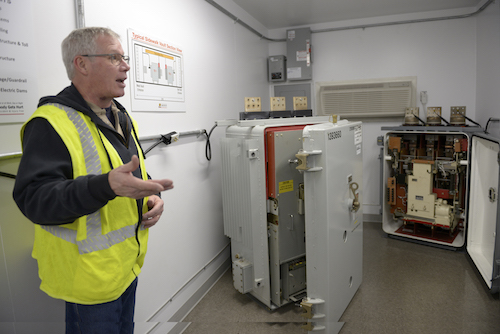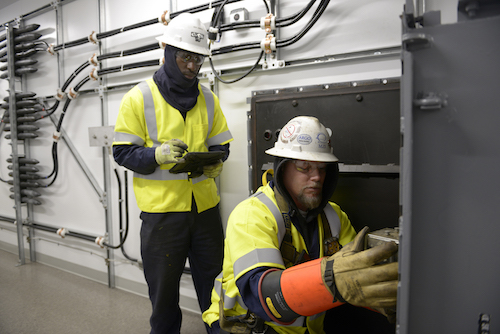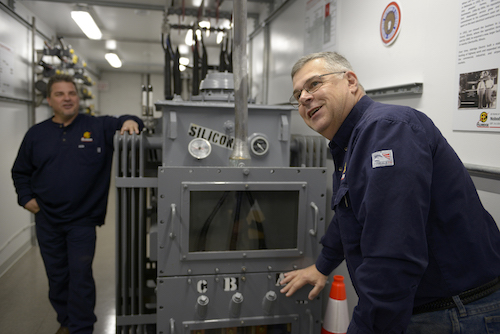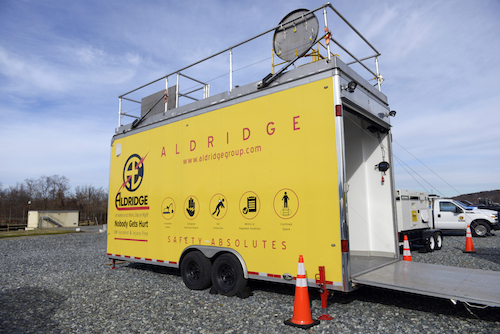IBEW members working underground have experienced sweeping changes in recent years. Private contractors are performing an ever-larger share of the work once done by public utilities. Increasingly technical equipment has put more demands on everyone. And concerns about safety linger, in part because there's been little standardization throughout the industry.

|
| Bill Sullivan, utility training manager for Aldridge Electric, stands in front of a network protector inside the training trailer that he and others designed for IBEW members.
|
But Bill Sullivan and his colleagues with Aldridge Electric, a signatory contractor based in Libertyville, Ill., are working to change that. In a coordinated effort with IBEW members, Aldridge designed a pair of trailers that will provide state-of-the-art training for underground workers across the country in a safe environment.
“Previously, training on utility projects was done on the job,” said Sullivan, a former member of Downers Grove, Ill., Local 15 who is now Aldridge’s utility training manager. “It was the sharing of tribal knowledge from whoever you were working with. If you were with someone who was really an ace, you might be fine, but it wasn’t standardized. You were working in a dark space and it was kind of a trial-and-error thing.
“Now we have an official training program through the use of the training trailers,” he said. “Everyone is being trained by the same manual and same trainer. The program creates a level playing field so everyone is on the same page.”
The two trailers made their debut last fall at a Pepco service center in Washington, D.C., drawing IBEW members from across the Eastern seaboard. Along with the training team, the units will move across the country, heading to multiple sites this spring.
“I was really impressed,” said Washington Local 70 Business Manager William Tipton, whose membership is primarily comprised of underground workers and Pepco employees. “It’s a step forward. I think every company doing this type of work should have something set up like this.”
Aldridge is one of the nation’s leading electrical contractors with annual revenues approaching $500 million. The company is well known for its work on complex infrastructure projects, including significant contracts with utilities and large-scale public contracts.“It’s pretty simple,” said the company’s owner, Alex Aldridge. “We want everyone to go home safe every night.That’s our culture and the reason we invested in developing this training program.”

|
| Torray James and Andy Chomor assess conditions on a network protector.
|
“Giving underground workers state-of-the-art training in a safe environment is a priority,” International President Lonnie R. Stephenson said. “It’s essential for our members, and it gives our partners another tool when pursuing work on underground projects that are becoming more common in the electrical industry. We are on the cutting edge of something special thanks to our partnership with Aldridge.”
Sullivan was named the project’s lead developer in February 2017. Two weeks later, he had a proposal down on paper. Within a few short months, the two trailers were up and running, having been built by IBEW members employed by Aldridge.
“The first thing I thought of was, ‘What can I do to improve safety?’” Sullivan said. “If I am going to set up a trailer that goes throughout the country, what can I do to support individuals who have already been trained to work on the infrastructure in their area and also people who want to work for a utility company?”
The first trailer is 53 feet long and includes a network transformer and network protector. The trailer is set up for normal maintenance training following established procedures. Or, Sullivan and other Aldridge administrators can bug it to show how to correct a particular problem. A generator under the trailer frame allows them to send power to the secondary network cables.
To teach how to properly assess a manhole, multiple cable joints are collapsed or cracked and workers use infrared cameras to determine if they were damaged by elevated temperatures or other abnormalities. The environment simulates the enclosed space underground workers usually find themselves in, but in a better-lit area. Instructors have an easier time teaching than they would in a dark vault below the surface.

|
| Aldridge project engineer Chet Chippie stands in front of a network tranformer's primary cable compartment with foreman and Chicago Local 9 member John Ficetti in the background.
|
The safety trailer is about 23 feet long and is a converted auto racing car hauler. It simulates training for removing a disabled worker during an emergency, complete with a 180-pound dummy wearing a work belt and helmet that workers hoist atop the trailer.
“I don’t know of any other contractor that has this,” Sullivan said. “Utilities have a luxury in that they have training centers that are brick and mortar. A contractor that works across the country doesn’t have that ability. To have this go nationwide, it’s important for the safety of the workers.”
Sullivan relied on Chicago Local 9 member and Aldridge general foreman John Ficetti and other IBEW members for input.
Newer electrical construction, Ficetti noted, is increasingly done underground instead of building overhead power lines. Initial costs are more expensive, but local officials believe it saves money over time. It’s also more visually pleasing, a top selling point for developers.
“It keeps it out of sight, it keeps it out of the weather and the elements and it makes the reliability stronger,” he said.
That provides more work for IBEW members, but it makes the training they receive even more critical. The trailers simulate the compact environment they’re likely to work in while helping members learn from instructors in a safe setting. Everyone completing the training receives a participants’ handbook they can continually refer back to.
“There is not a whole lot of knowledge regarding the underground networks, which is exactly why Aldridge put this together,” Ficetti said. “It’s why we made this trailer as realistic as possible. When you’re in the trailer, you’re going to do some things you would do down in a vault, but the conditions are a little better and you can ask questions.”

|
| The safety trailer designed by Aldridge is a converted race car hauler. It includes a simulated manhole atop it that allows IBEW members remove a 180-pound dummy wearing a work belt and helmet.
|
Local 9 member and journeyman lineman Andy Chomor said the trailer serves as a needed reminder for experienced members, too.
“Just being able to get your hands on some things that you may or may not experience on a daily basis is extremely important,” said Chomor, who has worked underground around the country for nearly 20 years. “As far as seeing everything you would see in a manhole situation, and physically testing everything in the manhole prior to going out and getting yourself potentially injured, you can be trained properly. You can’t put a dollar figure on safety.”
That’s the point made by Local 70’s Tipton, who noted that even experienced linemen might feel overwhelmed when asked to work underground for the first time. They increasingly are being asked to do so because of changes in the industry. The trailers should make that transition smoother, he said.
“If we sent a lineman that has been working overhead or in transmission or in a substation, if they go into a manhole, they’re going to be lost,” Griffin said. “They don’t know what they’re looking at.”
Fourth District Vice President Brian G. Malloy saw the trailers firsthand when they were in Washington. “I think it shows the commitment from Aldridge to our members’ safety,” he said. “I was quite impressed with it and I was quite impressed by our good relationship with the employer and the customer.”
Sullivan said the trailers aren’t designed to replace apprenticeship programs. But they do provide an additional tool by giving a more realistic simulation of working underground.
“I had one general foreman tell me, ‘I’ve been underground and been in manholes my whole career, but you’ve added another layer of training and showed me something I didn’t know before,’” Sullivan said. “That’s the best compliment we can get.”